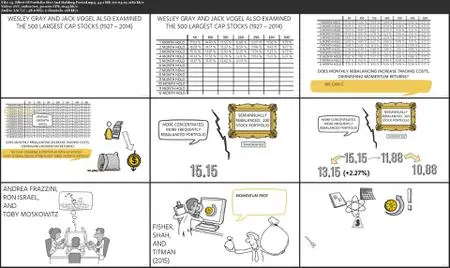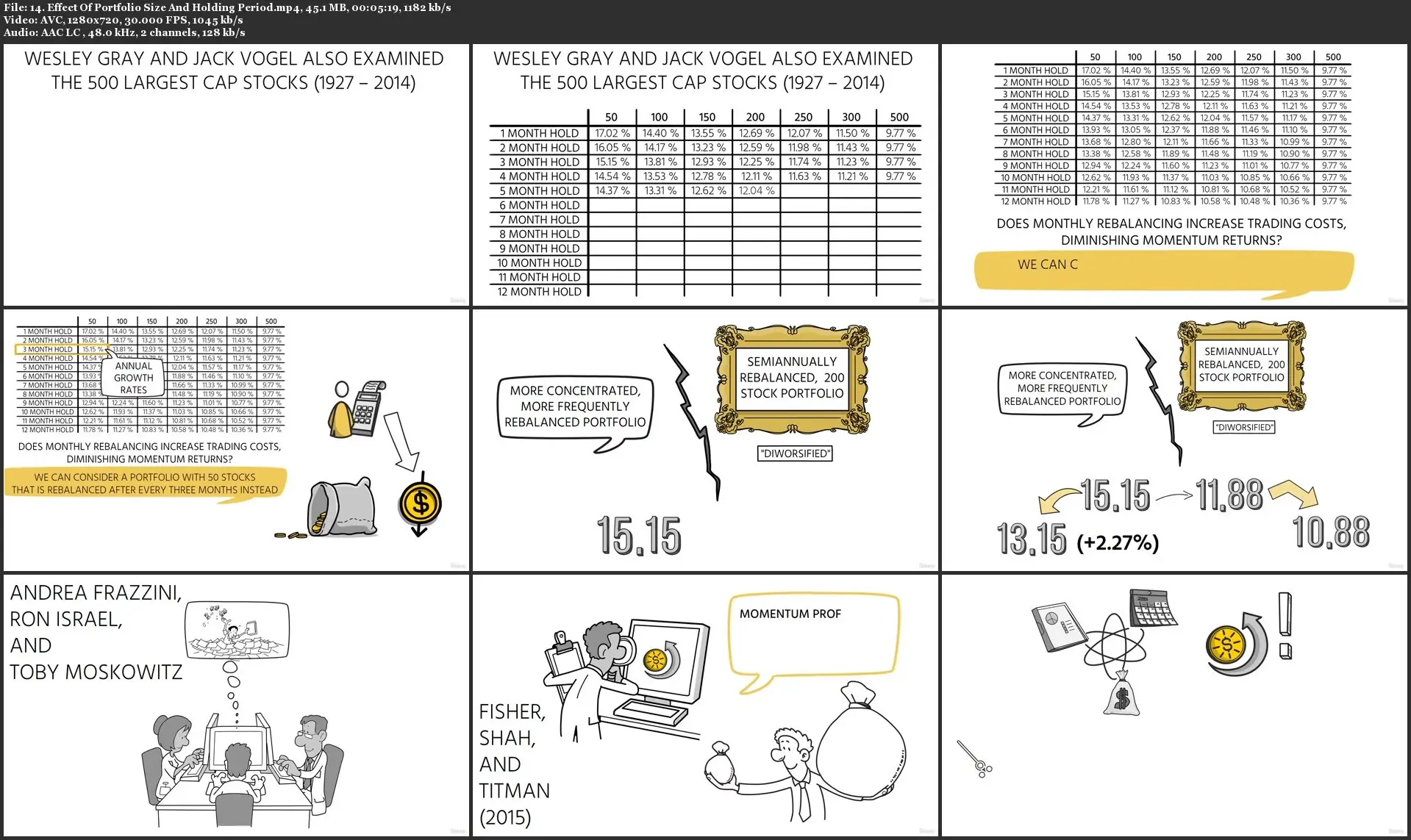Quant Trading Stock Market | Factor Investing with ML Python
.MP4, AVC, 1280x720, 30 fps | English, AAC, 2 Ch | 2h 17m | 1.06 GB
Created by Quant Alpha
.MP4, AVC, 1280x720, 30 fps | English, AAC, 2 Ch | 2h 17m | 1.06 GB
Created by Quant Alpha
Unlock the Power of Quant Trading Factor Investing: Build Optimally Diversified Risk Strategies with Superior Returns
- Recognize the basic principles of factor investing
- Develop a deep understanding of factor models and their applications
- Analyze the benefits and drawbacks of factor investing
- Understand the role of factor investing in portfolio construction
- Identify the differences between active and passive factor investing
- Assess the performance of factor-based investment strategies
- Develop the ability to construct and test a factor-based portfolio
- Analyze the risk-return characteristics of factor investing strategies
- Understand the impact of factor investing on market efficiency
- Develop the ability to implement factor investing strategies in practice
- Compare and contrast the different types of factors and their importance
- Understand the concept of factor tilts and their role in portfolio construction
- Analyze the historical performance of different factors in different market environments
- Understand the limitations and biases of factor-based investment strategies
- Develop the ability to identify and manage factor-specific risks
- Analyze the differences between single-factor and multi-factor investing strategies
- Develop a clear understanding of the statistical concepts behind factor investing
- Analyze the economic and behavioral factors that underlie factor investing
- Understand the impact of factor investing on asset allocation decisions
- Evaluate the role of factor investing in modern portfolio theory
- Develop the ability to identify and exploit market anomalies using factor-based investment strategies
- Analyze the differences between equity and fixed income factor investing
- Understand the importance of diversification in factor-based portfolio construction
- Develop the ability to interpret and analyze factor exposure in a portfolio
- Identify the common pitfalls of factor investing and how to avoid them
- Evaluate the impact of macroeconomic factors on factor-based investment strategies
- Understand the role of factor investing in managing systemic risk
- Analyze the differences between factor investing and other investment approaches, such as value and growth investing
- Understand the impact of factor investing on corporate governance and social responsibility
- Develop the ability to construct a factor-based portfolio using various optimization techniques
- Develop the ability to construct a factor-based portfolio using various optimization techniques
- Analyze the differences between long-only and long-short factor investing strategies
- Develop the ability to evaluate and select appropriate factor-based investment products
- Understand the impact of factor investing on risk management and hedging strategies
- Identify the challenges of implementing factor investing in emerging markets
- Understand the role of factor investing in sustainable investing and ESG considerations
- Analyze the role of factor investing in the context of different investment objectives
- Understand the impact of factor investing on market dynamics and market structure
- Develop the ability to backtest factor investing strategies and analyze their performance
- Identify the potential sources of factor mispricing and their impact on factor investing strategies
- Analyze the differences between factor investing and smart beta investing
- Understand the role of factor investing in managing tail risk
- Evaluate the impact of technological advancements on factor-based investment strategies
- Develop the ability to construct a diversified factor-based portfolio across different asset classes
- Understand the impact of factor investing on factor crowding and its implications
- Analyze the differences between passive and active factor investing approaches
- Understand the role of factor investing in tactical asset allocation and market timing
- Evaluate the impact of geopolitical factors on factor-based investment strategies
- Develop the ability to measure and monitor the performance of factor-based investment strategies
- Analyze the differences between factor investing and traditional asset allocation strategies.
Requirements
You will learn everything you need to know about factor investing in this course
Description
"Factor investing is an investment approach that targets specific drivers of return to help improve portfolio outcomes, diversification and reduce volatility." -BlackRock (10 trillion USD AUM)
"Factor based investing is not just about picking stocks, it's about understanding the underlying drivers of market performance and making informed investment decisions that lead to sustainable gains" -Wesley Grey, Ph.D
Are you tired of blindly following the stock market and leaving your investment returns to chance?
Look no further than factor-based investing strategies!!!
What is Factor Investing?
Factor investing is one of quantitative finance's most commonly used building blocks for trading & investment strategies. As a result, many investors and large money management institutions depend primarily on factor investing research when investing. Factor investing is a way to take a systematic look at companies. Companies are ranked against each other based on one or more factors that show their attractiveness. Companies that are ranked higher are companies that present a greater chance to generate alpha, a significant positive returns long-term expectancy; therefore, factor investing aims at identifying these factors to provide a mechanism to build sound portfolio construction techniques that allows sophisticated investors to achieve above-market profits prudently. This powerful strategy is based on the idea that certain characteristics or "factors" of a company, such as its size, value, or momentum, can be used to predict its future returns. By focusing on these key factors, you can potentially identify undervalued stocks and improve your overall investment performance.
Factor-Based Investing is a modern investment approach that uses a set of well-known and understood factors to identify and select securities that are expected to perform well in the future. These factors include, but are not limited to, value, momentum, size, and quality. By focusing on these factors, Factor-Based Investing has been proven to deliver strong returns while also reducing risk. In fact, studies have shown that Factor-Based Investing outperforms traditional investment strategies in the long run. The three most common factors used in factor-based investing are value, momentum, and size.
1. Value stocks, which are stocks that are considered to be undervalued by the market, have historically had higher returns than growth stocks, which are stocks that are considered to be overvalued by the market.
2. Momentum stocks, which are stocks that have had strong past performance, have also had higher returns than stocks with weak past performance
3. Small-cap stocks, which are stocks of companies with a small market capitalization, have historically had higher returns than large-cap stocks, which are stocks of companies with a large market capitalization.
4. Quality Stocks, which is the tendency of high-quality stocks to outperform low-quality stocks
Factor-based investing has become increasingly popular in recent years and the assets under management (AUM) in smart beta funds reached around $1.5tn in 2021. According to Morningstar, smart beta funds have outperformed traditional cap-weighted index funds in the US and Europe for the past decade. Research has shown that a combination of factors can potentially lead to higher risk-adjusted returns than using a single factor. However, it's important to note that past performance does not guarantee future returns, and factor-based investing strategies may not always be successful. This course is designed for individuals who are looking to gain a deeper understanding of how factor-based investing works and how to implement it in their own portfolio.
This course is suitable for a wide range of investors, including:
Beginners: If you are new to investing or are looking to expand your knowledge, this course will provide a solid foundation in factor-based investing.
Experienced investors: If you have experience investing in the stock market but are looking to improve your returns and manage risk more effectively, this course will give you the tools you need to do so.
Professionals: If you work in the finance industry or are a financial advisor, this course will give you the knowledge and skills you need to help your clients achieve their financial goals.
Whether you're just starting out or are a seasoned professional, this course will give you the knowledge and skills you need to succeed with factor-based investing. With comprehensive lessons and practical exercises, you'll be able to put your new knowledge into action right away. This course on factor-based investing is unique because it offers a comprehensive and in-depth understanding of the subject matter.
Here are a few key features that set it apart from other courses:
Advanced strategies: This course goes beyond the basics of factor-based investing and covers advanced strategies such as multi-factor investing and smart beta.
Real-world applications: This course not only covers the theory of factor-based investing but also provides real-world examples of how it can be applied to create successful portfolios.
Use of cutting-edge tools: This course teaches students to use the latest tools and technologies, such as machine learning and artificial intelligence, to analyze and optimize portfolios.
Flexible learning options: The course offers flexible learning options, such as online and self-paced options, to cater to the diverse learning needs of the students.
Interactive sessions: The course includes interactive sessions such as Q&A, peer discussions, and group work, which create a dynamic learning environment and allow students to learn from each other.
Emphasis on Risk management: This course places a great emphasis on risk management, providing students with a comprehensive understanding of how to minimize risk while maximizing returns.





